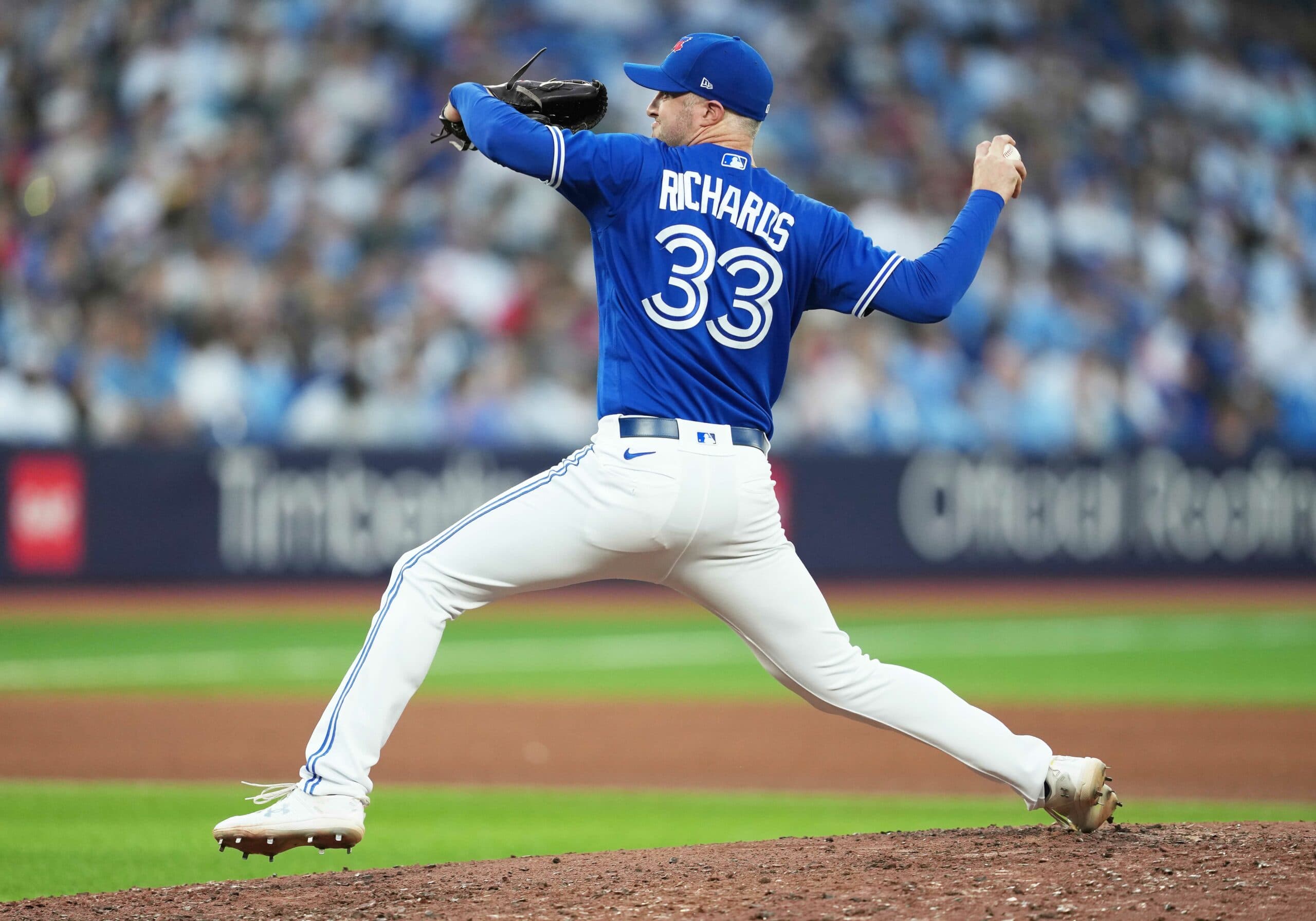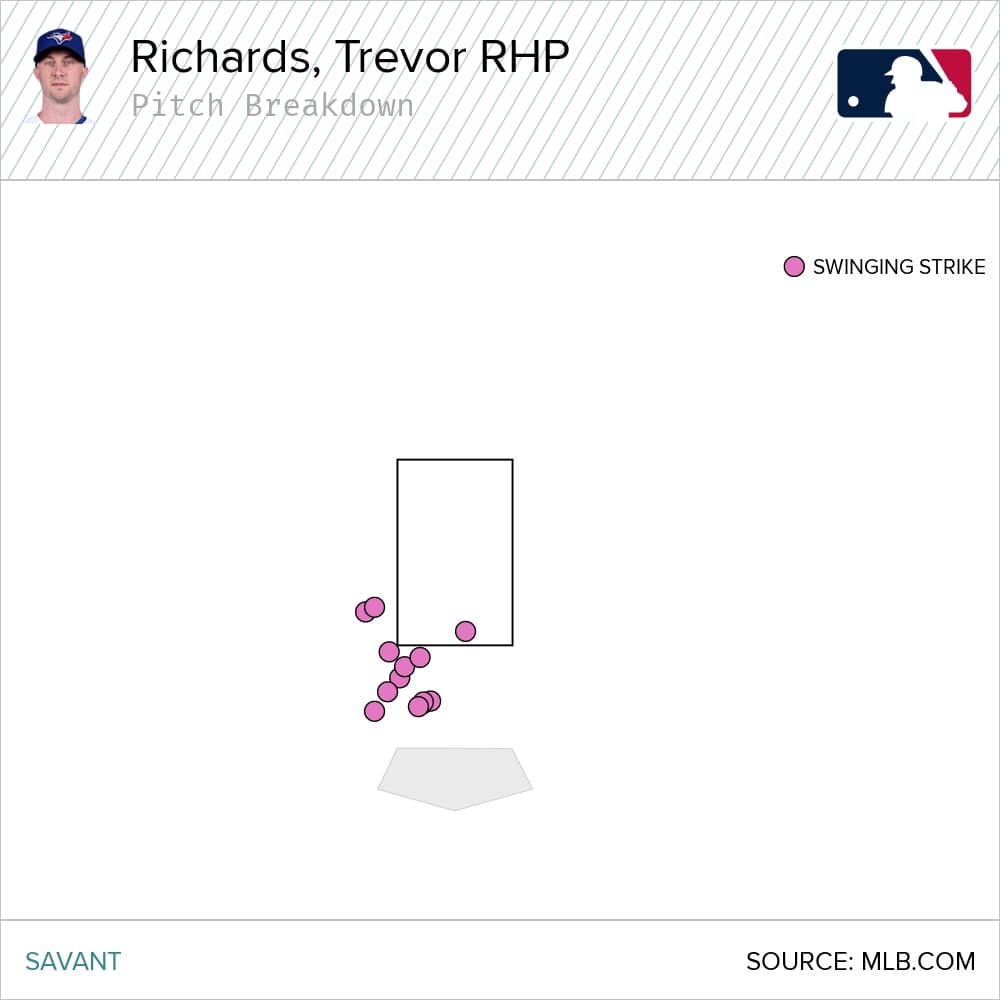Stretching out Trevor Richards could be a necessary gamble

Photo credit: Nick Turchiaro-USA TODAY Sports
By Thomas Hall
Jun 13, 2023, 14:00 EDTUpdated: Jun 13, 2023, 15:41 EDT
Coming off last Saturday’s impressive opener start, right-hander Trevor Richards finds himself in an intriguing position as the Toronto Blue Jays continue to move forward without one of their top starting pitchers, Alek Manoah.
The first Manoah-less-turn through the rotation was a resounding success, which saw Richards begin the designed bullpen day against the Minnesota Twins, tossing three scoreless innings before giving way to left-hander Tim Mayza. Together, the pair allowed just three baserunners to reach and didn’t surrender a run across 4.1 innings.
Richards was excellent and exceeded all expectations, charged with just one hit and a walk while punching out seven – the most strikeouts he’s recorded in a start since July 22, 2019 – increasing his strikeout rate to a career-high 38.9 per cent. He also induced 16 whiffs, 13 via his changeup, tied for the second-most in his career.
As shown in the chart below, 12 of those 13 swinging strikes occurred outside the strike zone as the Twins hitters repeatedly chased at his devasting changeup.

Source: Baseball Savant
Of the three balls that were put in play against Richards, only one produced an exit velocity beyond 95 m.p.h. – Edouard Julien’s 103.1-m.p.h. leadoff double to open Saturday’s contest. Other than that, the 30-year-old righty was effective at limiting hard contact, that is, during the few times Minnesota’s lineup was able to make contact.
Upon completing his third inning of work, the 6-foot-2 hurler had thrown 53 pitches, the most he’s racked up since Sep. 17, 2020 – one of his four opener starts with the Tampa Bay Rays. Even so, given how dominant he had been up to that point, it’s fair to wonder what may have happened if the Blue Jays sent him back out for the fourth inning.
It made sense to pull Richards after the third, though, as it prevented him from facing two lefties (Alex Kirilloff and Trevor Larnach) and Carlos Correa for a second time, all of whom were retired in order by Mayza. That strategy also allowed Bowden Francis to face the bottom of the order once he entered from the bullpen.
Francis, however, was optioned back to triple-A Buffalo on Sunday in favour of Thomas Hatch and won’t be eligible to return – barring an injury – when Manoah’s spot comes around again next weekend in Texas. Thus, should the Blue Jays consider pushing Richards further than three innings during the next bullpen day?
At this point, nothing should be off the table. But first, Toronto must decide when to schedule its next bullpen game. Thanks to Monday’s off day, there is an opportunity to juggle the starting rotation, which could happen following this three-game series versus the Baltimore Orioles.
Chris Bassitt, José Berríos and Yusei Kikuchi have each been announced as starters, respectively, ruling out the possibility of a bullpen day occurring in Baltimore. If the rotation remains unchanged, there would be an opening on Friday against the Rangers, allowing Kevin Gausman to pitch on five days of rest – which usually improves his effectiveness – the following day.
The downside to that plan is several relievers would likely be required on consecutive days, similar to this past weekend. Since Gausman has typically pitched deep into games, swapping him with Manoah’s spot probably makes the most sense, separating Kikuchi’s start and the planned bullpen day.
Either way, Richards should be preparing to work multiple innings against the Rangers’ potent lineup, a matchup that’ll see him face one of the most explosive offences in baseball this season. And it’ll almost certainly be much tougher to create as many swings and misses in his second start of 2023.
Unlike the Twins, who lead the majors in strikeout rate (27 per cent), the Rangers are a much more disciplined team, as they feature the fourth-lowest called-strike-plus-whiff percentage (26.3 per cent), are tied for the seventh-lowest chase rate (29.7 per cent) and own the 14th-lowest strikeout rate (22.5 per cent).
Texas’ offence also excels versus changeups, producing a .303/.335/.500 slash line with an 18.0 run value – which leads all of baseball – creating a less-than-ideal matchup for Richards. Even so, not many big-league pitchers feature a changeup as superior as his, an aspect that should bode well the first time through the order.
When it comes to stretching out Richards, though, things could become tricky. The first reason is that doing so would limit his availability in other critical situations, just as it did last Friday when Adam Cimber was called upon to pitch in extra innings. And that move didn’t end favourably for the Blue Jays.
But that is the trade-off for using Richards as a multi-inning opener. For example, after throwing 53 pitches over three innings last Saturday, he might not be available out of the ‘pen for manager John Schneider until Wednesday. If he opens this Saturday in Texas, that probably takes him out of action for Thursday and Friday, potentially reducing his availability as a reliever to once per week.
The benefit to this, however, is that lengthening the former starter could eliminate having Mitch White, Thomas Hatch, Cimber or all three pitch in the same game. And with Gausman likely throwing the day before, Schneider may have most of his high-leverage weapons available, namely Nate Pearson, who can also throw multiple innings.
On the other hand, the Blue Jays could do everything right, sacrifice Richards’ availability during the week and plan to push him beyond three innings, only for the Rangers to chase him from the game before that point. Then they would have no choice but to rely on White, Hatch and Cimber.
That may be a necessary risk, though, considering Richards worked into the fifth inning as an opener multiple times with the Rays in 2o20. He compiled as many as 86 pitches in that role, working as deep as 4.2 innings in a start versus the New York Yankees on Sep. 1, 2o20.
Could the Blue Jays stretch him out just as far? Perhaps. If they do, it’ll be vital to remember that opponents slashed .322/.355/.492 against him a second time through the order in 2020, producing a 6.23 ERA in 13.0 innings.
Richards, of course, is a vastly different pitcher in 2023, ditching his ineffective curveball to form a sensational fastball-changeup combination. With it, he has quickly transformed into one of Toronto’s most impactful hurlers, sitting tied with Erik Swanson for sixth on the team in fWAR (0.3).
Since few alternatives are available, having Richards pitch the bulk of this club’s next bullpen game is a gamble likely worth taking. And if it pays off, perhaps it could translate into something more than a short-term role.
ARTICLE PRESENTED BY BETANO

Breaking News
- First World Series appearance in 32 years earned Blue Jays players $354K each
- Blue Jays: Vancouver Canadians win 2025 Bob Freitas Award at High-A level
- Blue Jays trade Justin Bruihl to Guardians for cash considerations
- Blue Jays: 3 potential trade partners for Jose Berrios
- The Blue Jays need a bounceback campaign from Anthony Santander in 2026
